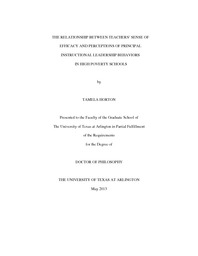
ATTENTION: The works hosted here are being migrated to a new repository that will consolidate resources, improve discoverability, and better show UTA's research impact on the global community. We will update authors as the migration progresses. Please see MavMatrix for more information.
Show simple item record
| dc.contributor.author | Horton, Tamela | en_US |
| dc.date.accessioned | 2013-07-22T20:15:27Z | |
| dc.date.available | 2013-07-22T20:15:27Z | |
| dc.date.issued | 2013-07-22 | |
| dc.date.submitted | January 2013 | en_US |
| dc.identifier.other | DISS-12141 | en_US |
| dc.identifier.uri | http://hdl.handle.net/10106/11894 | |
| dc.description.abstract | The purpose of this study was to examine the relationship between teacher perceived principal instructional leadership behaviors and teacher self-efficacy in high poverty schools. Data on these variables was gathered using the Teachers' Sense of Efficacy Scale (Tschannen-Moran, 2001) and the Principal Instructional Management Rating Scale (Hallinger, 2011). The study also explored the relationship between teacher self-efficacy and years of experience. Hierarchical multiple regression and correlation analysis was used to explore the relationship between the variables. The study found a significant relationship between teacher perceived principal instructional leadership behaviors and teacher self-efficacy. Of particular note was the repeated observation that the self-efficacy of teachers in high poverty schools can be supported through principal's framing and sharing the campus goals. | en_US |
| dc.description.sponsorship | Hardy, James C. | en_US |
| dc.language.iso | en | en_US |
| dc.publisher | Education | en_US |
| dc.title | The Relationship Between Teachers' Sense Of Efficacy And Perceptions Of Principal Instructional Leadership Behaviors In High Poverty Schools | en_US |
| dc.type | Ph.D. | en_US |
| dc.contributor.committeeChair | Hardy, James C. | en_US |
| dc.degree.department | Education | en_US |
| dc.degree.discipline | Education | en_US |
| dc.degree.grantor | University of Texas at Arlington | en_US |
| dc.degree.level | doctoral | en_US |
| dc.degree.name | Ph.D. | en_US |
Files in this item
- Name:
- Horton_uta_2502D_12141.pdf
- Size:
- 797.4Kb
- Format:
- PDF
This item appears in the following Collection(s)
Show simple item record


